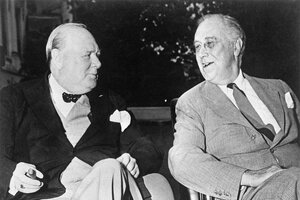In the White House, Winston Churchill found a home away from home
With a new biography, Robert Schmuhl walks readers through Winston Churchill’s frequent stays at the White House – and the strong bonds those sojourns forged.

British Prime Minister Winston Churchill (left) and American President Franklin D. Roosevelt chat during one of Churchill’s extended stays at the White House in the 1940s.
Keystone-France/Gamma-Rapho/Getty Images
With summer travel season in high gear, many of us might face the prospect of a challenging houseguest. In that spirit, let’s remember the patience of former first lady Eleanor Roosevelt, who weathered repeat visits by British Prime Minister Winston Churchill, a man celebrated for his charm but exhausting to have around.
Or so we learn in “Mr. Churchill in the White House,” Robert Schmuhl’s lively account of the prime minister’s frequent – and lengthy – stays at 1600 Pennsylvania Ave.
Churchill arrived for his first extended visit at the White House on Dec. 22, 1941, just days after the Japanese attack on Pearl Harbor had plunged America into World War II. Great Britain had been in the war since 1939, and Churchill welcomed the opportunity to discuss strategy. It was a good idea, no doubt, though the first lady apparently hadn’t received much advance word. Things went downhill for her from there.
President Franklin D. Roosevelt and Churchill reportedly got along famously, though the president’s wife proved less enthusiastic. Churchill was fond of keeping the president up late at night, then napping during the day, with FDR continuing to work while the prime minister caught some shut-eye. It proved a recipe for exhaustion for the chief executive. “It always took him several days to catch up on sleep after Mr. Churchill left,” she recalled.
The prime minister’s presence in the Executive Mansion brought other misadventures – including, as the story goes, an incident in which FDR accidentally surprised Churchill as the prime minister was rising from a bathtub. In the most popular telling of the tale, Churchill brushed off the awkwardness by declaring, “You see, Mr. President, I have nothing to hide.”
Did this oft-cited episode actually happen, and did Churchill really save the day with that clever remark? Schmuhl walks us through numerous accounts of the bathtub story, earnestly puzzling out what seems most plausible. Not all readers will share the author’s interest in such a lengthy review of the historical sources, but they will grasp the pleasure Schmuhl takes not only in telling this story but inhabiting it.
Maybe the most important thing about the bathtub anecdote is its symbolism, underscoring the casual intimacy that Roosevelt and Churchill enjoyed. Both men felt so much at ease that Churchill was welcome to stay even when FDR was away.
They seemed destined to form a strong bond: Both hailed from patrician backgrounds, excelled at oratory, loved a good time, and embraced a sense of themselves as historic leaders.
Similarities, of course, can just as often breed contempt. How did two such powerful egos work so closely together? Churchill, who viewed U.S. support as critical for his country’s survival, seemed to grasp that sublimating his strong personality to accommodate Roosevelt could sometimes help. “No lover ever studied every whim of his mistress as I did those of President Roosevelt,” the prime minister would note years later.
Churchill served as prime minister from 1940 to 1945, then again from 1951 to 1955. In the World War II years, arduous boat journeys between England and America created a rationale for Churchill to stay awhile once he arrived in Washington. Schmuhl’s chapter on Churchill’s experience as President Dwight Eisenhower’s guest, starting in 1953, reads like an elegy, since the jet age was emerging, and quicker diplomatic trips became the standard.
After Churchill’s death in 1965, a bronze bust was donated to the White House, and it’s been in various places there ever since.
Churchill, to the delight of many, has become the guest who never leaves.

